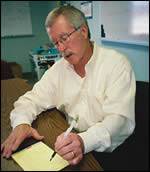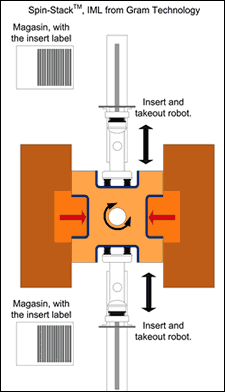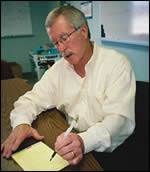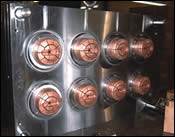Surface Finish, Productivity Musts for Packaging Industry
VMCs providing superior surface finish while enhancing productivity help packaging moldmaker stay competitive in the thermoforming industry.
While producing molds for the packaging industry doesn’t require a great deal of high tolerance work, productivity is everything. That said, even though a mold may not have to hold a thousandth of an inch tolerance, it is vital that the package fits the product it is protecting.
Fortunately, vertical machining center (VMC) manufacturers are producing machines that not only are more efficient, but provide excellent surface finishes at faster rates—which in turn allows the moldmaker to take on more work. Molds for the packaging industry need to run faster and yield predictable performance as well as little or no post-mold handling. J&R Plastics, Inc. (Acushnet, MA)—a designer and manufacturer of molds for the thermoforming industry, which are used to produce many different types of packages—turned to Haas Automation, Inc. (Oxnard, CA)—a manufacturer of CNC vertical and horizontal machining centers, CNC lathes, rotary tables and 5C indexers—to help meet its needs for quality packaging molds in a shorter timeframe.
Bit of History
J&R Plastics, Inc. was founded by brothers Joseph Amarello Jr. and Randy Amarello in January 2000—operating out of a 2,000-square foot rented mill-type building. By 2003, J&R had run out of space and had to decide whether to continue renting or build a new facility. Electing to build, the company moved into its current 9,500-square foot facility in June 2004. Today, the 13-employee company is in the process of adding another 7,100 square feet for a total of 16,600 square feet.
According to J&R Plastics Vice President Randy Amarello, designing and building molds for the thermoforming industry has been the company’s singular mission since its inception. Amarello recalls he and his brother were exposed to the industry in college, and old habits die hard. “We happened to land jobs as tooling engineers for a rapidly growing thermoforming company,” he says. “With our background in the machining trade—combined with our mechanical engineering degrees—the industry simply was a good fit.
“The nice thing about thermoforming tooling is that nearly all components of the tool package are manufactured out of aluminum, which machines at much faster feeds and speeds than, for example, tooling in the injection molding industry,” Amarello continues. “It also seems to be a relatively tight-niche industry. There are not a lot of truly qualified thermoforming toolmakers out there. Sure, there are shops that can cut a mold cavity of a model that may get supplied to them, but there are few that understand how all components of the tool package are going to process any given part. We have both the tool building know-how as well as the understanding on how it will process the plastic package. We also have the machine tool equipment that can run 24 hours a day, seven days a week, which allows us to maximize productivity. Providing the highest quality tooling at competitive prices is what keeps our customers coming back.”
Thus, building packaging molds for the thermoforming industry became J&R Plastics’ specialty. “Our molds are used to produce many different types of packages like blisters, tray, clamshells, tri-folds, etc.,” Amarello notes. “This type of packaging is commonly used in various industries. Some examples are consumer goods (packages for razors and flashlights); food packaging (containers for berries and herbs); medical (trays for handing many different types of medical devices); electrical (packaging for handling electrical components such as PC boards); and the board game industry (typically trays with many compartments which hold all of the game pieces).”
Packaging Perils
Not surprisingly, maintaining productivity is a significant challenge for J&R Plastics. “It is challenging to try and keep up with the workload,” Amarello states. “Not with equipment, but with people power. We are very fortunate to be so busy; however, the tooling is very engineering-intensive. As a toolmaker specific to the thermoforming industry, we only see a particular mold package once. Reorders for the same designs are nonexistent. Our customers come back—but always for new projects—which means new designs. Also, we specialize in the entire thermoforming tooling process, which consists of the forming station, trimming station and stacking station. Completing an entire tooling package requires designing and manufacturing many components that fit into many different footprint thermoforming machines. The designs are often like puzzles—where every component is unique for the particular package being formed.
“Thermoforming is a fairly large industry, but yet it’s a small industry, if that make any sense,” Amarello continues. “It is very large due to the fact that you can find this type of packaging virtually everywhere; however, it is very specialized, which makes it difficult to find a knowledgeable labor pool. This makes employment/growth difficult—but we are fighting through it as we are committed to growth and have had no problem committing to new technology to maximize productivity. Our goal is to continue to meet our customer’s needs and we are fortunate to have a work staff that is very knowledgeable and always dedicated to providing the quality that meets and exceeds our customers’ expectations.”
In addition, while tolerances aren’t critical—Amarello notes that typically +/- .005 on an inch is more than adequate—he says J&R Plastics prefers to use the terminology, “functionally accurate” since the final package produced from the mold must fit the product like a glove. “The types of surfaces we machine are often very difficult to measure with standard measuring tools,” Amarello emphasizes. “Any given mold can have many flowing surfaces that change directions. Therefore, it is very common that we first produce a prototype for customer approval before proceeding to the final multi-cavity production mold. This allows our customers to make sure the product fits that package exactly as desired.”
The majority of this packaging mold work is surface machining, Amarello continues. “The surface finish of our molds is very critical,” he explains. “Any sign of machine lines in the mold will transfer to the finished plastics blister package. The better the finish that comes out of the machining center, the less handwork/polishing that is required. We take great pride in the quality of our molds and we believe that is a large component of why we are so busy.”
J&R Plastics also had capacity issues. The footprints of the company’s first two CNC machining centers were not ideal for the type of work it was doing. “Many of the molds we machined were 30 inches by 30+ inches; however our previous CNCs did not have the table travel to accommodate that size mold with one program,” Amarello recalls. “We had to program the mold in halves—which means that we machined the first half and when completed, rotated the mold so that we could finish the machining of the other half. Having to perform twice the setups just was not helping our productivity.”
A Fine Finish
To address both surface finish and capacity issues, J&R Plastics chose vertical CNC milling centers from Haas Automation, Inc. The shop has six Haas machines in-house with different size footprints—the VF-1, VF-2, VF-3, VF-5, VF-6 and VF-9. “These machines give us table travel capabilities of 16" x 20" up to 40" x 84",” Amarello states. “This arsenal of equipment has allowed us to produce virtually any mold size and shape that our customers have thrown at us.”
While researching CNCs, Amarello learned from his thermoforming industry peers that Haas machines “gave a lot of bang for the buck.” Other Haas CNC plusses include easy-to-learn controls and the fact that these CNCs have the power and features Amarello wanted at a “relatively economical” price.
“The Haas controller has a very easy-to-use touch pad and runs very well with most all CAD/CAM software packages,” Amarello elaborates. “The machine comes with various options for spindle rpms—which is critical for high-speed machining. All of the molds that we produce are out of aluminum, which is a material that runs very well with the higher rpm spindles. We also run lights-out, which means that we set up all long-running jobs toward the end of the day, load the program, press go and walk away. The programmable coolant feature is a big key to this capability. It allows us to walk away from the machines with confidence. We are not worried about endmills breaking due to the coolant not getting to the tip of the endmill after tool changes. The programmable chip auger assists in keeping the machine clean. While there is still some manual cleaning involved, it definitely helps on those overnight runs.”
Plenty of Productivity
According to Amarello, purchasing the Haas machines allowed J&R Plastics to purchase the aforementioned six machines over a four-year period and still stay within the company’s budget. Additionally, determining factors for Amarello were the quality of the molds produced (finishes), machining speeds, lights-out operation and capacity. “We believe that we achieved all of these goals with our machine tool selection,” he says. “When we started our business we easily could have spent our money on a so-called higher end machine, but we would have fell short on capacity, which has been a critical factor for meeting our customers’ needs."
Amarello recommends other moldmakers in the packaging industry “take a close look at your real needs and your budget. Research the different equipment available and choose what is best for you. For us, the solution was Haas vertical milling centers and we are very pleased with our choice.”
Related Content
Laser Welding Versus Micro Welding
The latest battle in finely detailed restoration/repair of mold materials.
Read MoreFour Micro Tooling Considerations
Issues involving gating, ejection, mold splits and direction of pull are of special concern when it comes to micro tooling.
Read MoreThe Ins and Outs of Hot Runner Temperature Control
A training checklist that explains the why and how of proper hot runner temperature control and system management.
Read MoreHands-on Workshop Teaches Mold Maintenance Process
Intensive workshop teaches the process of mold maintenance to help put an end to the firefighting culture of many toolrooms.
Read MoreRead Next
In-Mold Labeling Looks to High-Output Molds for Growth
Moldmakers seek to combine ultrafast cycles and high-speed automation in tool designs.
Read MoreMold Builders Carve Lean Niche
Commodity-oriented consumer manufacturing left North America, but mold industry survivors are finding strong growth in technical market sectors.
Read MorePackaging Molds Go High-Tech to Improve Productivity and Economy
The ability to design and build innovative molds for advanced processing needs is key to being competitive and profitable in a low-margin market.
Read More




















